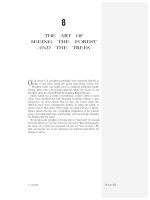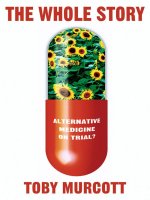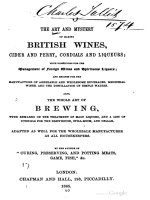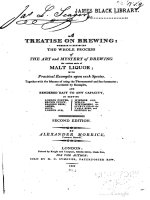Seeing the whole
Bạn đang xem bản rút gọn của tài liệu. Xem và tải ngay bản đầy đủ của tài liệu tại đây (5.45 MB, 115 trang )
Seeing the Whole
by
Dan Jones
Jim Womack
foreword by John
Tai Lieu Chat Luong
Shook
SHINGC
F'RIZE
for EXCELLENCE iJ
MANUFACTURINC
Seeing the Whole
Mapping the Extended Value Stream
By Dan Jones and Jim Womack
Forevvord by John Shook
The Lean Enterprise Institute
Cambridge, MA USA
lean.org
Version 1.1
February 2003
With gratitude to Dan Jones's colleagues at the Lean Enterprise Research Center, Cardiff University,
in particular Nick Rich, Dave Brunt, Dave Simons and Matthias Holweg, who helped pioneer extended
value-stream mapping.
And with further gratitude to our reviewers, editors and designers (who bear no responsibility for
the remaining faults): Jose Ferro, Bruce Henderson, Dave LaHote, Graham Loewy, Dave Logozzo,
Bob Morgan, Guy Parsons, Atisa Sioshansi, Peter Tassi, Jeff Trimmer, Helen Zak, Maria Elena Stopher,
and Thomas Skehan of OffPiste Design.
And with special gratitude, as always, to John Shook.
© Copyright 2002 The Lean Enterprise Institute, Inc.
One Cambridge Center, Cambridge, MA 02142 MA USA
Tel: 617-871-2900 •Fax: 617-871-2999 • lean.org
ISBN 0-9667843-5-9
All rights reserved.
Design by Off-Piste Design, Inc.
Printed in the USA
May 2008
=
i
Whenever there is a product for a customer, there is a value stream.
The challenge lies in seeing it.
-
Mike Rother & John Shook, learning to See
When you have learned to see value streams in individual facilities,
it's time to see and then to optimize entire value streams,
from raw materials to customer.
FOREWORD
When the first item in the Lean Tool Kit, Learning to See, was launched in June of 1998,
we at LEI began to hear from managers in many industries that "this is the tool we have
been looking for." Readers quickly realized that the great power of Learning to See lies in
focusing attention on the value stream for individual product families within plants. Rather
than concentrating on isolated processes along the value stream or aggregated activities
serving many value streams, readers could suddenly see how to optimize the flow of each
product from receiving to shipping. This insight was breathtaking for many managers
caught up in narrow techniques or looking at only one activity in a complex system.
As more and more people heard about Learning to See and began to practice value stream
mapping, we began to hear of additional needs. "How can we introduce continuous flow at
the process level within facilities?" And, "How can we expand the scope of value stream
mapping beyond individual facilities to the extended value stream from raw materials to
the end customer?" Many readers suspected that if there was vast muda within the walls
of each facility there was even more muda between facilities and firms.
We had been thinking about this issue long before June of 1998. Indeed, the initial outline
of Learning to See devoted equal attention to mapping the extended value stream. However,
we knew that extended mapping is more challenging than facility-level mapping and we soon
concluded that we would need several publications. In addition, we realized that managers
would do well to hone their skills by "learning to see" within a limited area before venturing
forth to "see the whole".
We therefore included a diagram in Learning to See illustrating different levels of mapping.
We've recently addressed the process level with Mike Rother and Rick Harris' Creating
Continuous Flow. In Seeing the Whole we tackle the higher, extended levels.
process level
Creating Continuous Flow
single plant
Learning to See
Why is an extended map harder to draw? It's not because the fundamental concept is
different. At every level of mapping, we are simply observing and writing down every step
in information processing and physical transformation for individual product families. We
observe the flow of customer desires moving up the value stream, in the form of orders or
schedules, and then observe the progress of products moving downstream in response to
this information, from raw materials to finished items.
Extended mapping is harder because we need to map across plant, divisional, and company
boundaries. In addition, we must pay careful attention to the variability in order and materials
flows. Finally, we need to think about untangling, simplifying, and "right sizing" complex
logistics and information systems, large facilities, and high-scale processing technologies
serving many value streams and operated by many firms.
Conducting extended mapping requires the cooperation of many departments and divisions
within firms and between firms. These entities rarely think about the total flow of individual
products and often hide information from each other while pushing in opposite directions.
In addition, extended mapping requires that line managers devote hard-to-spare time to
direct observation of each product family's value stream. Failing this, higher-level mapping
easily becomes a staff exercise (or a consulting project) yielding only another report that's
soon forgotten.
These additional dimensions of extended mapping truly are challenges. However, we have had
considerable success in overcoming them, including recent instances during the preparation
of this workbook. We now are certain that change-agent managers can meet these challenges
and we know that time already devoted to learning to see at the process and the facility levels
will prove invaluable as you expand your field of view.
As with Learning to See, we hope users of Seeing the Whole will tell us how to improve
this tool and will be willing to share their experiences with the lean community. Numerous
user suggestions, based on hands-on experience with value stream mapping at the facility
level, have permitted us to improve Learning to See several times since its first publication.
We look forward to an intense and continuing dialogue with the lean community on Seeing
the Whole as well. Please send your comments and suggestions to
e Controls Sbe
~i.t>"-
John Shook
Senior Advisor, Lean Enterprise Institute
Ann Arbor, Ml, USA
March 2002
"¢.
:3k
~ ~~~\i-\~
~ ..\i.:1rl?<
a.>
~
\l
/,>~
'~)%~ ~
.
~
v,
\I"· "'laQ\ '0
\1~~1\\ ,i\·
II'
~
~
._<;J
\,~,~
~
vvvvvv.lean.org
~
CONTENTS
Forevvord by .John Shook
Introduction: Changing Your Focal Plane
Part I:
Getting Started
Part II:
The Current State Map
Part Ill: What Makes an Extended Value Stream Lean?
Part IV:
Future State 1
Part V:
Future State 2
Part VI: The Ideal State
Part VII: Achieving Future States
Conclusion
About the Authors
Appendix A: Value Stream Mapping Icons
Appendix B: Facility-Level Current State Maps
Appendix C: Facility-Level Future State Maps
INTRODUCTION
Changing Your Focal Plane
For years now we have loved to "take a walk" along the entire value stream for a
given product, looking for value and waste. We've done this for dozens of products
in many industries and followed streams across the world. We presented our first
example in Lean Thinking (1996) when we drew the path of a humble cola can.
This simple product with only three parts (barrel, top, and "pop-top") traveled 319
days through nine facilities owned by six companies in four countries to progress
from ore in the ground into the hands of the customer. Yet during this long march
only three hours of value creating activities were performed and the great majority
of the steps -
storing, picking, packing, shipping, unpacking, binning, checking,
reworking, and endless movements of information to manage the system's complexity
-
created no value at all.
Looking at the whole has always seemed natural to us and doing so will always
suggest ways to slash costs while dramatically improving responsiveness and quality.
Yet most managers we have encountered on our value stream walks want to stand
in one place and look at only one point -
their machine, their department, their
plant, their firm. Often, the machine, the department, the plant, and the firm are
performing well on traditional measures defects, on-time shipments -
high labor and machine utilization, low
and the managers are pleased with their achievements.
However, when we get managers to change their focal plane from their assets and
their organization to look at the product itself and what is actually happening on its
long journey, they immediately realize that the performance of the entire value
stream is abysmally sub-optimal. Indeed, most wonder how they have worked for
years in traditionally compartmentalized operations and somehow failed to notice
the waste everywhere. Then they wonder what they can do about the mess.
And that is the big challenge. Managers find it easy and fun to draw extended
current state maps. And this is a critical first step because it raises consciousness.
But providing a management tool that permits the waste to be removed permanently
by achieving successive future states has been much harder. It was only when we
first saw Mike Rother and John Shook drawing future state value stream maps at
the facility level and coupling these maps to an action plan for implementation that
we begin to see how we might guide groups of managers streams are shared across many departments and firms for entire streams.
for all extended value
toward similar results
In this breakthrough guide we present our method. It proposes a progression
through two "future states" to an "ideal state" after the current state is jointly
identified and agreed. The first future state will be relatively easy and creates the
setting for the second. The second future state is considerably harder and reaching
the ideal state will require a major commitment by all the firms touching the product.
Yet we believe that the savings in time and effort and the improvements in quality
at every step will encourage teams to keep going once they learn how to jointly
optimize the shared stream.
Eventually, with some creative thinking about process and information technologies,
we believe that most value streams can be compressed and smoothed to a point
where a large fraction of the original steps and practically all of the throughput time
are eliminated. This will be a true revolution and the value stream team getting
there first will have an overwhelming competitive advantage. More important in
most cases, the team getting started first and making the quickest progress along
the path will have a continuing competitive advantage.
The key is to summon your courage, form your cross-department and cross-company
team, and change your focal plane to focus on the product. Then learn to see the
whole and ... get going to take out the waste! We will be urging you on and waiting
to hear about your problems and successes.
Dan Jones and Jim Womack
Ross-on-Wye, Herefordshire, UK
and Brookline, MA, USA
March 2002
What is Extended Value Stream Mapping?
An extended value stream is simply all of the actions wasteful -
both value-creating and
required to bring a product from raw materials into the arms of the
customer. The relevant actions to be mapped consist of two flows: (a) orders traveling
upstream from the customer (or from the sales department when forecasts substitute
for confirmed orders) and (b) products coming down the value stream from raw materials
to customer. Together these constitute a closed circuit of demand and response.
Value stream mapping is the simple process of directly observing the flows of
information and materials as they now occur, summarizing them visually, and
then envisioning a future state with much better performance.
Maps of the extended value stream can be drawn for products currently in production
or for future products being planned. The only difference is that the "current state"
map for a product in production shows conditions as they exist today while the
"current state" map for a new product shows the "business as usual" approach to
making the product compared with alternative "future states" and "ideal states"
with less waste and greater responsiveness.
Selecting a Product Family
The whole point of value stream mapping is to disaggregate operational issues to
the level of specific products, where they can be more easily acted on by managers.
To do this you need to start at the furthest point downstream (toward the customer)
to be mapped and to define product families at that point. Typically a product family
will include a group of product variants passing through similar processing steps and
using common equipment just prior to shipment to the customer. For example:
• In a power tools business, a product family might be medium-sized electric
drills utilizing a common chassis and passing through a common assembly cell
as the last manufacturing step, even though the finished product has many
different features and customer labels. Alternatively the mapping team might
define the product family as the motor going into the medium drills and map
back upstream from that point.
• In the auto industry, a product family might be a car platform (e.g., Ford Explorer
and Mercury Mountaineer) produced in an assembly plant. Alternatively it might
be a major component supplied to auto assemblers -
let's say an alternator -
using a common design architecture and assembled in a cell, but with varying
power outputs and with different attachment points for different vehicles.
PART I: GETTING STARTED
1
• In the aerospace industry, a product family might be an entire airframe
(e.g., the Boeing 737 or Airbus A320). Alternatively, it might be a major subassembly, for example the vertical tail. The sub-assembly may have many
variants for different buyers of the completed aircraft. For example the tail
structure might incorporate different aerials and fairings for navigation and
communication equipment. And the products within the family chosen for
mapping might differ slightly in dimensions. For example, the basic tail
design might be slightly longer for use on a stretched airframe. However,
the vertical tail clearly constitutes a product family because all variants
follow the same manufacturing path and have no commonality with tails
for other aircraft, even if they are made in other areas of the same facilities
by the same firm utilizing parts from the same suppliers.
Note that the same product family may be supplied to a number of different
end customers and have cosmetic differences causing the casual observer to
overlook product commonality. Nevertheless from the standpoint of the firm or
facility at the downstream end of the map, the product is clearly a family.
Note also from the chart below that firms along similar value streams often
have complex relations with each other. Delta supplies similar components to
both Summa and Zenith; Omega fabricates similar parts for Delta and
Azimuth; and Illinois Steel supplies materials to Theta and Zeta as well as
Omega. Extended mapping cuts through this clutter to focus on just one
stream in order to think of improvements that can eventually apply to all streams.
Final
Assembly
Component
Assembly
Part
Production
Ravv Material
Production
Summa
Apogee
Kappa
Asia Steel
Platform A
••••••••••••••••••••••••••••••
Platform B •• ••
Delta
Zenith
1··-··-·.
1·-·-·-·
·
~ .1
\I
~·· ,.----•:
Theta
.
. / Illinois Steel
} ••
•/
1
•rl--\-·-·-·-· I\
\~....
•
i
.\ :
.\...I
.•
Platf orm A - · - · - · - · - · - ·
Platform B - · · - · · \
•
·.
I
'··-··--··
Admiral
Perigee
Platform A••
Platform B ·-· ......
Comet
\
.
·<--,---'.
~
\
..
··••.............•....
Zeta
., ..\:..
\
...
......
\Ohio Steel
.
··-··-··-
••••....I' ·-· ·-· ·-·
......
Azimuth
.. .. .. ..
.,,/;
I\
1···••
Omega
/
.
•••···················
Monterrey Steel
Platform A - - - - - - - - - -~ ..,, ·-· ·-· ·-· ..I ..
Platform B ••••.•.• , •.•.•. ·• .• , • , •.•.•.•.•.•.•.•.• , •.•.•.• , •.•.• , •.•.•.•.• , •
Firms along similar value streams often have complex relations with each other.
Product Families from Summa's Perspective
Smith Heat
Treatment
Utopia
Castings
Cosmic
Brakes
Eclipse
Engine
Computers
Because the product family is defined from the vantage point of the final step mapped, the
concept is essentially "fractal". That is, you can define product families from many starting
points and map backward up value streams of varying lengths. For example, what appears to
be a product family for an armature manufacturer (large armatures for alternators) is simply
one of many component parts for an alternator producer (who might define a product family
as large alternators). And the large alternator is just one component among many from the
standpoint of the auto assembler who defines product families in terms of vehicle platforms.
As you select your start point and move back upstream, it is best for your first map to follow
the path of a single family and a single component in the product. This is because the first
objective of extended mapping is to achieve a breakthrough in shared consciousness of
waste and to identify systematic opportunities for eliminating the waste. It is highly likely
that the wastes identified by following one component back upstream will occur in roughly
equal measure in every component going into the finished product. The alternative approach
of mapping the value stream of every component going into the product is time consuming
and costly and we have found that it overwhelms managers with too much data.
In subsequent rounds of mapping -
if the collaborators in the mapping process find ways
to work together and achieve useful results -
additional maps can be created for many or
all of the components and parts going into a finished product. But to get started, keep it
simple and focus first on achieving a breakthrough in raising your team's consciousness!
PART I: GETTING STARTED
3
Determining a Manageable Field of Vievv
The ideal map would truly show the whole. That is, it would start with the end customer
who uses or consumes the product. The map would then follow the product all the way
up the value stream to molecules in the ground (or in the recycling bin), showing all the
wasted actions and information loss en route. However, just as trying to map all of a
product's parts back upstream is overwhelming, trying to see too far with your current
vision may be fruitless. We advise novice mappers that a lot can be learned by looking
one or two facilities and firms upstream from wherever you start. This is the minimum
scope of extended mapping.
Single Facility Field of Vievv -
Learning to See
18,400 pcs/mo
-12,000 "l:'
-6,400 "R"
II
Tray = 20 pieces
2 Shifts
Daily Ship
Schedule
I.------.
STAMPING ...-&-+
&
Coils
5days
4600L
2400R
CllC&•
1100L
600R
1..._Qi1
S. WELD#2
...,.
ID&•
1600L
850R
'91
A5SEMBLY#1
iau&-+
1200L
640R
~01
A55EMBLY#2
C/l = 39 seconds
CIT = 40 seconds
C/0 = 10 minutes
CIT = 46 seconds
C!O = 10 minutes
CIT = 62 seconds
CJD= 1 hour
C!O= 0
CID= 0
Uptime= 85%
Uptime= 100%
Uptime= 80%
Uptime= 100%
Uptime= 100%
27,600 sec. avail.
5days
2 Shifts
2 Shifts
2 Shifts
2 Shifts
27,600 sec. avail.
27,600 sec. avail.
27,600 sec. avail.
27,600 sec. avail.
7.6days
1 second
1.8days
39 seconds
2.7 days
46 seconds
SHIPPING
Staging
Production
Lead Time = 2 :3.Gdays
2days
62 seconds
uu&-+
2700L
1440R
'91
CIT = 1 second
EPE = 2 weeks
4
S. WELD#t
200T
4.Sdays
40 seconds
Processing
= 188sec
Time
Even at this minimum scope, note that the scale of maps changes dramatically between
Learning to See (facility-level maps) and Seeing the Whole. The facility boxes that are the
primary units of analysis in this breakthrough guide are the same size as the individual process
boxes ("stamping", "welding", "assembly") in Learning to See. Vast expanses of people and
equipment within facilities have been shrunk into tiny boxes so we can see the big picture!
In this guide, we will draw maps with an intermediate field of view, starting at the distribution
center for the completed product and proceeding upstream to raw materials (e.g., rolls of steel).
For those with more ambition and with full cooperation from upstream facilities and firms,
it is both possible and desirable to start near the end customer and work far back upstream
toward raw materials.
Multiple Facilities Field of Vievv -
Seeing the Whole
I
960/Day
~
1 ~Day
6'-0A
426ST
214HT
320B
213ST
107HT
TIME
0.3d.
STEPS
'""''
Steps
= 73
4.0d.
0.25d.
0.25d.
20.6cl (3131 s.)
2.0d.
4.6 d. {30 5.)
22(3)
4
21(3)
4.0d.
4.0d.
0.5d.
4
4
0.5d.
2.8d. (120s.)
11(2)
Value
Creati~g
= 8
""''
PART I: GETTING STARTED
5
Choosing a Leader and a Value Stream Team
We hope that you are experienced with facility-level mapping as described in Learning
to See and have appointed value stream managers for all of the value streams within
your facilities. We are convinced that this is critical to gain the full benefit of mapping
at the facility level. What's more, the knowledge of facility-level value stream managers
will be invaluable for quickly drawing accurate maps of the extended value stream.
However, by their nature, extended maps cross facilities and firms. Suppose managers are
in place for the segments of the stream within each facility. Who has the responsibility
for directly managing the total stream across firms, to connect the maps and lead the
improvement process? The reality in most cases will be "no one". So there is a need for
a new type of manager who we will call the "Product Line Manager" (PLM).
The Product Line Manager
This individual in the most downstream firm needs to be much more than a technician
concerned with one facility. Indeed, for optimal results the Product Line Manager needs
to be a business manager. This means "business" in the sense of taking responsibility
for making money and growing market share with the product family in question. And
it means "manager" in the sense of looking concretely at the precise actions that need
to be taken all along the value stream to remove waste and cost while improving quality
and responsiveness.
The most successful firms we have encountered using these techniques have Product
Line Managers who think about product marketing and engineering as well as production
and purchasing. With all the elements of marketing, design, production, and supply chain
under his or her oversight, this individual is in a unique position to judge the performance
of the many functions touching the product. Indeed, as we will see in a moment, a
continuing assessment of functional performance along with precise prescriptions for
improvement is one of the most important benefits of product line management.
However, we do not usually recommend what is sometimes called a "product team"
structure in which all of the engineering, operations, purchasing, and marketing
employees supporting the product are put on a dedicated team. Doing this causes a
large amount of organizational disruption during the transition and this structure still
does not address the behavior of upstream partner firms. What's more, it is really not
necessary in most cases if the PLM takes an energetic approach to the job.
6
Perhaps the best known example of what we are talking about in the
manufacturing world today is the Chief Engineer for a car platform
at Toyota (a job position also called the shusa). This individual is
widely known by everyone in the company and takes responsibility
for the success of the product in terms of return on investment and
market share. Yet the Chief Engineer, like our proposed PLM, actually
has no direct authority over marketing (which is done by a large
marketing department), over engineering (which is done by the
various parts of the large engineering department), over production
(which is done by the operations department), and over suppliers
(who are managed by the purchasing department, and the production
control and logistics department.) Instead the Chief Engineer, working
with a tiny group of assistants, is the one person who can "see the
whole" and think about the necessary contributions from every
functional activity and every upstream firm to create and deliver
a successful product as judged by the end customer.
The PLM in the most downstream firm will be even more effective
if there are similar individuals in each of the upstream firms so that
for any product a quick evaluation can be conducted by a small
group composed of one PLM per firm.
But this is not likely to be the case. Indeed, in today's world very
few firms have true PLMs. (One of our concerns in preparing this
breakthrough guide has been that the very managers most able to
benefit from it don't currently exist in many firms!) Thus to get
started, someone from one of the functional areas in the most
downstream firm will probably need to take the lead and aim to
achieve a breakthrough in consciousness. This individual probably
will have little formal authority for overseeing the value stream and
will therefore need to lead by example and by raising hopes about
possible joint gains.
We can't guarantee that anyone anywhere along a value stream can
succeed in raising every participant's consciousness to transform the
entire stream. We can guarantee that anyone anywhere can raise the
important issues and make constructive change a possibility where it
was previously impossible ... if they have the courage to act.
To be successful, the mapping leader needs to be someone who can gain the respect
of upstream partners by conducting a rigorous and fair process. Logical candidates are
from purchasing, production control, logistics, operations, or a process improvement
function like quality or process engineering. Any of these can work. However,
assigning a buyer from purchasing to be a mapping leader can lead to problems if
upstream participants believe that the real purpose of mapping will be to uncover
waste at suppliers, followed by demands for immediate price reductions. Thus a
purchasing function will probably need to assign mapping leadership to someone
from its supplier development group if all participants are to be convinced that the
process is fair, balanced, and aimed at win-win-win outcomes.
The value stream team needs to include representatives of all the firms and facilities
that share ownership and management of the stream. Ideally, it would also include
the relevant departments within each firm -
sales, operations, production control
and logistics, purchasing, manufacturing engineering, information management, and
product engineering. However, this can make the team too large to walk the value
stream together, which is often a critical learning experience. Thus we generally
recommend a small team with a minimum of one representative per company.
The team can query the functions supporting the value stream as necessary to fill
in missing information.
The Wrong Role for Consultants and Staffs
An understandable inclination in any firm with busy line managers
-and this surely includes practically all firms-is to delegate the
task of creating value stream maps to outside consultants or to
internal staff groups, typically in operations planning or process
improvement departments. However, in our experience this is
misguided. The findings of the consultant or staff expert are
rarely credible to the managers who need to take action and the
consciousness raising experience of walking the value stream
together-discovering the waste and jointly agreeing to a crossfirm action plan-simply never happens. A beautiful report ls
<;
produced by the consultant or staff team-and in our experience
the beauty and precision of the maps is generally inversely
proportional to their usefulness-but the findings are then filEfd
away and soon forgotten.
Remember: Only managers taking clear responsibility can fix
the mess. So the same managers ought to draw the maps.
8
Taking a Walk
Once designated, the leader and the team need to take a walk together
along the value stream, draw the current state map, and then ask, "Which
steps create value?, Which steps are waste?, Why is order flow so erratic?,
Why is quality so erratic?, Why are deliveries so erratic?, How can value
be enhanced for the end-customer?"
Once the map is drawn so that the current state of an existing value
stream is known precisely, it's time to create the first of two "future
state" maps that remove wasted steps while stabilizing processes and
simplifying information flows. Future State 1 achieves the future state
shown in Learning to See within each facility touching the product.
This means introducing continuous flow (as described in Creating
Continuous Flow) wherever possible and instituting smooth, leveled
pull between the areas of continuous flow.
Future State 2 then introduces smooth, leveled pull with
frequent replenishment loops between every facility
touching the product. In the process, most
warehouses are eliminated, or converted
to cross dock operations.
An Ideal State may then co-locate
at one site all of the activities required
to proceed from raw materials to finished
goods, in the process eliminating practically
all transport links and needs for information
management.
You may or may not find this particular sequence
appropriate for your own value streams. In particular, if
you are mapping a new value stream for an entirely new product
you will probably want to skip directly from the current (businessas-usual) state to an ideal state. We follow the three-step sequence,
beginning with Future State 1, in this breakthrough guide because
we believe that this is likely to be the most typical
approa~h.
PART I: GETTING STARTED
9
Tvvo Final Benefits
A Diagnostic for Functions
As teams draw their current state value stream maps, they are likely to make a surprising
discovery. Most problems identified along the value stream will trace directly to the
performance of various functions -
information technology, production control, logistics,
product engineering, operations, purchasing. What's more, weaknesses in functional
performance discovered in the sample value stream will almost certainly be present
in every other value stream the firms touch. In our experience, the functions want to
support the value stream for each product. But they have a hard time seeing the
connection between their activities and the needs of the product.
Thus an important benefit of the mapping process -
in addition to a breakthrough
in consciousness about the magnitude of waste and the enormous opportunities for
improvement -
can be to give much clearer guidance to each function about its role
in supporting value streams. A real bonus can be achieved if the improved functional
performance can then be applied to all value streams within the participating firms.
A Diagnostic for Relations Betvveen Firms
As teams start mapping, they are likely to make yet another discovery. Today we all use
language stressing partnership and cooperation between firms sharing value streams.
However, mapping teams in most cases will discover an enormous gap between these
high-level principles of collaboration and the day-to-day reality down at the level of
each value stream. If the value stream map shows widespread confusion and counterproductive actions between firms at the value stream level, it will be obvious that
"partnership" at the top isn't translating into competitiveness at the bottom.
Fortunately, value stream mapping provides a clear and consistent language for firms
to start an intelligent conversation with each other about the root causes of their shared
cost, quality, reliability, responsiveness, and communications problems. (Indeed, we
believe a relentless, fine-grained focus on improving each value stream, rather than
high-level agreement on principles, is what has given Toyota its edge in creating the
world's leanest supply base.) A real bonus can be achieved if the practical lessons of
shared value stream management can then be applied by each firm to its relations
with its other customers and suppliers.
10
~···
The Current State Map
With the basic principles of extended mapping in hand, it's time to accompany a value
stream team creating a map of the current state for a specific product family. This map
will characterize the value stream as it is today.
We've chosen to focus on a high-volume automotive component offered with a small number
of options -
a windshield wiper consisting of a blade holding the actual wiping edge and the
arm attaching the blade to the vehicle. This product is similar in complexity and variety to
the steering column bracket used to illustrate Learning to See.
We've decided to map only an intermediate portion of a total value stream, which runs its
entirety from the end user (you in your car) at the downstream end to raw materials (iron
ore in the earth) at the upstream end. The portion we will map starts at Alpha Motors, the
final assembler of the finished vehicle, toward the customer end of the value stream. We
then proceed back up the stream through the facilities of Beta Wipers and Gamma Stamping
to the shipping dock at Michigan Steel, a raw materials service center. The five-member
team, from the four firms sharing this portion of the value stream, will be led by the head of
supplier development in the purchasing department at Alpha Motors and includes the product
line manager and the assembly plant manager at Beta Wipers, the value stream manager for
this product family at Gamma Stamping, and the sales manager at Michigan Steel.
Windshield Wiper Value Stream Team
Information
flow
Michigan Steel
~
Sales Manager
Gamma Stampers
Beta Wipers
~ Value Stream
~ Product Line
'\ . Manager
'\ · Manager
t
~
Alpha Motors
Plant Manager
Head of Supplier
Development
(Team Leader)
Material
flow
PART II: THE CURRENT STATE MAP
11
Windshield Wiper Assembly and Fabrication Path
--....
brackets
stiffener and wiping edge
Windshield Wiper Assembly and Fabrication Steps
A. Rolled steel stamped into blade spine
B. Four brackets attached to blade spine
C. Wiping edge attached to blade spine and brackets assembly
D. Blade assembly attached to arm
E. Assembled wiper attached to automobile
12
---......._,









